Warsaw 22nd March- There was no official ticket counter in Warsaw Central train station. Instead, there were only 3 unofficial-looking small booths to buy train tickets and they look like our money-changer shops in Singapore. Didn't manage to take a picture.
- Impressed by the presence of policemen in Warsaw. 1. We were standing in line to buy the train ticket and an old beggar approached a nun behind us. A policemen came and chased him out of the train station. He stood outside the train station and the nun took pity on him and bought him a baguette. 2. At the train station, there's a gallery that overlooks the platforms for the trains. There were policemen standing at the gallery and watching out for potential problems at the platforms. 3. There was an Italian Embassy near our hostel and there were 2 policemen patrolling the area. We couldn't find our hostel and asked them for directions. Thankfully, they could speak English.

Visited the church where Chopin's heart is. I thought we would see a preserved heart and not a block of wall!

The majestic State Opera House right in the city centre.

Along a street in Warsaw. Notice the presence of a gate (background) in between the buildings. This is the entrance to Warsaw University.
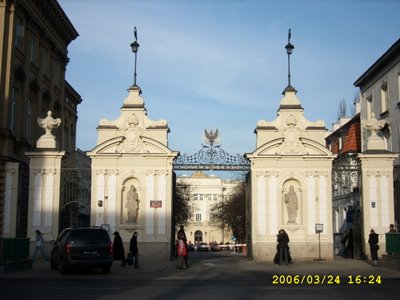
The entrance to Warsaw University.
 Warsaw's Old Town. The buildings were destroyed during the war but were carefully reconstructed after the war to resemble its pre-war state.
Warsaw's Old Town. The buildings were destroyed during the war but were carefully reconstructed after the war to resemble its pre-war state.
 The Town Hall. Also reconstructed after the war to resemble its pre-war look.
The Town Hall. Also reconstructed after the war to resemble its pre-war look.

Krakow: 23-24th March
- We were affected by the Daylight Savings Time in Krakow. We didn't adjust our watch forward by an hour. As a result, we missed the private guided tour to the concentration camp and had to take the public transport to the camp. It turned out that it was not necessary to take any private tour since the admission ticket already includes a guided tour.
- Auschwitz concentration camp is quite depressing. It's a fabulous place to visit and offers a different experience from castles, cathedrals and museums. Europe seems to be all about castles, cathedrals and museums. Getting tired of visiting castles, cathedrals and museums. We didn't step into a single museum during this trip. ;)
- Met a few Singaporeans studying in Imperial College. The Singaporean accent is so obvious. haha!
 An interesting looking person in the Old Town Square.
An interesting looking person in the Old Town Square.
 Krakow opera house on a Saturday morning. We wanted to watch a show to kill time on our last night before taking the night train but didn't manage to.
Krakow opera house on a Saturday morning. We wanted to watch a show to kill time on our last night before taking the night train but didn't manage to.
Wieliczka Salt Mine
 Statues made of rock salt. Apparently Poland became rich because of the discovery of salt.
Statues made of rock salt. Apparently Poland became rich because of the discovery of salt.
 View of the cathedral. The walls and other structures are made of rock salt.
View of the cathedral. The walls and other structures are made of rock salt.
 A statue of Pope John Paul made of rock salt. It was carved to commemorate his visit to the Salt Mine.
A statue of Pope John Paul made of rock salt. It was carved to commemorate his visit to the Salt Mine.
Auschwitz-Birkenau Concentration Camp
 Entrance to Auschwitz I Concentration Camp. The entrance to the camp (middle foreground) is marked with a cynical sign that reads "Arbeit macht frei", i.e., "Work Makes Free".
Entrance to Auschwitz I Concentration Camp. The entrance to the camp (middle foreground) is marked with a cynical sign that reads "Arbeit macht frei", i.e., "Work Makes Free".
 Map showing the deportation of Jews from various transitory camps and ghettos over Europe during 1942-1944. There were none from Denmark and Sweden. Hee. Sweden was neutral during the war and Denmark successfully sent most of its Jews to Sweden.
Map showing the deportation of Jews from various transitory camps and ghettos over Europe during 1942-1944. There were none from Denmark and Sweden. Hee. Sweden was neutral during the war and Denmark successfully sent most of its Jews to Sweden.
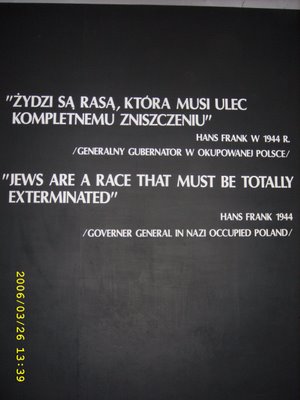
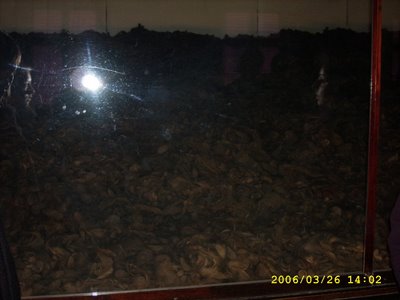 In the concentration camp, nothing was wasted. The hair of the dead Jews were recycled and made into fabric.
In the concentration camp, nothing was wasted. The hair of the dead Jews were recycled and made into fabric.
 Spectacles were also recycled and used as raw materials for the productions of factory goods.
Spectacles were also recycled and used as raw materials for the productions of factory goods.
 Photographs of some prisoners.
Photographs of some prisoners.
 Auschwitz II or Birkenau Camp where most of the extermination took place. This camp functioned as an extermination camp rather than a work camp. This is the fence surrounding the camp. The barb wire was connected to electricity and many inmates used it to commit suicide.
Auschwitz II or Birkenau Camp where most of the extermination took place. This camp functioned as an extermination camp rather than a work camp. This is the fence surrounding the camp. The barb wire was connected to electricity and many inmates used it to commit suicide.
 A fence separating the different sections of the camp.
A fence separating the different sections of the camp.
 The camp measures 2.5km by 2km. The prisoners who were building the camp deliberately worked slowly. They knew that the slower they built the camp, the slower the rate of deportation of their own people.
The camp measures 2.5km by 2km. The prisoners who were building the camp deliberately worked slowly. They knew that the slower they built the camp, the slower the rate of deportation of their own people.
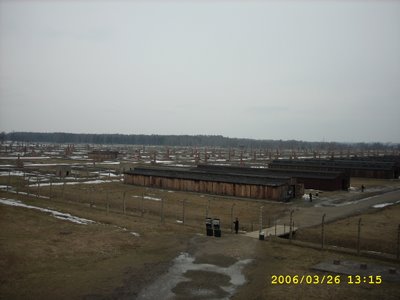 Part of the camp which is still standing.
Part of the camp which is still standing.
 The railway lines that extended into the camp itself. After the people had arrived by cattle cars, "selection" took place immediately. The choices were to be killed immediately, used as labour force or subjects in medical experiments which include sterilisation experiments.
The railway lines that extended into the camp itself. After the people had arrived by cattle cars, "selection" took place immediately. The choices were to be killed immediately, used as labour force or subjects in medical experiments which include sterilisation experiments.
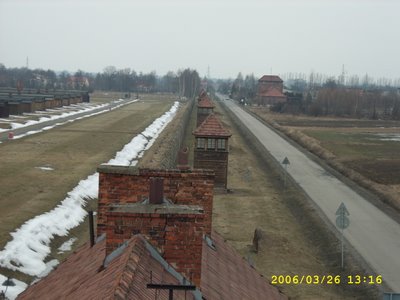 The guard posts separating the camp from the outside (right-hand-side).
The guard posts separating the camp from the outside (right-hand-side).
 As many as 12 people could be sleeping on one bed. In order to change sleeping position, everyone has to turn at the same time. This action was usually coordinated.
As many as 12 people could be sleeping on one bed. In order to change sleeping position, everyone has to turn at the same time. This action was usually coordinated.
 An old picture showing the sleeping condition back in those days.
An old picture showing the sleeping condition back in those days.
 Gas chamber.
Gas chamber.
 A room that is about the size of a phone booth. This is a form of punishment where 4 prisoners were made to stand the entire night after an exhausting day of work. They would then go to work the next day and return to their standing postion at night. Many died of suffocation or exhaustion.
A room that is about the size of a phone booth. This is a form of punishment where 4 prisoners were made to stand the entire night after an exhausting day of work. They would then go to work the next day and return to their standing postion at night. Many died of suffocation or exhaustion.
Prague (Czech Republic):27th-28th March
- Prague is a beautiful city with many quaint old houses. It's a truly unique capital that has barely any high-rise buildings.
- Sadly, the people are not the nicest people in the world. Image of the city was marred on the first day at Prague Castle where we were treatly rudely by the lady at the ticket counter. Prague Castle is a popular destination with scores of tourists and yet there is no quality service standard within the tourist attraction. We were also treated in a hostile manner at two other bakery shops in the city centre itself and in a metro station at the suburbs. The ladies at the shops were irritated with us for no reason and were pretty rude. On the flip side, there were two kind souls who took the initiative to ask if we needed help when they saw us looking at our map. One of them warned me to watch out for my purse.
- Got caught by a ticket inspector for not validating our metro ticket. He wanted to fine us S$35. We didn't have that much with us cos we were leaving by the night train. He told us to change money or withdraw cash at the metro station. I would have given him the money foolishly but I'm glad we didnt cos the money is likely to go into his pocket. Thankfully Sharon was smart and told him that we needed to return to our hostel to get money. He wanted one of us to stay there with him and the other to take the money. We negotiated with him and he finally let us go together. Before he released us, he scolded us in his language, threatened to send our ISIC card (we handed it to him foolishly at the start) to the respective embassies and warned us that we will be in trouble if we don't return in 15 minutes' time. We told him okie and took the metro to some stop and simply walked and walked and walked aimlessly on the street. We were really quite shaken by the experience.
- LOTS of tourists in Prague. Although it's called "Paris of the East" and is deemed as a romantic destination, seeing and banging into the vast number of tourists dosen't really fit into the idea of a romantic holiday.
- We finished Prague in 1.5 days and went shopping for one afternoon. Typical girls' activity. =)
 Part of Prague Castle.
Part of Prague Castle.
 Changing of the Czech guards.
Changing of the Czech guards.
 An interesting but cruel statue outside the Parliament House.
An interesting but cruel statue outside the Parliament House.
 View of the old town and Charles Bridge (middle) from Prague Castle.
View of the old town and Charles Bridge (middle) from Prague Castle.
 Old Town Square. The place was flooded with tourists.
Old Town Square. The place was flooded with tourists.
 View of the river from Charles Bridge.
View of the river from Charles Bridge.
 View of Prague Castle from Charles Bridge.
View of Prague Castle from Charles Bridge.
 The famous Charles Bridge in Prague.
The famous Charles Bridge in Prague.
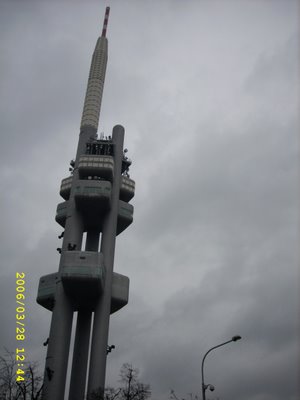 Zizkov TV tower used for all telecommunications purposes. It's not a fantastic-looking tower but the figurines of the little children scaling the tower help to beautify the tower a little. ;)
Zizkov TV tower used for all telecommunications purposes. It's not a fantastic-looking tower but the figurines of the little children scaling the tower help to beautify the tower a little. ;)
 View of Prague from the TV tower. These houses look like toy houses. ;)
View of Prague from the TV tower. These houses look like toy houses. ;)
 Notice that the buildings are relatively short. The tallest building in Prague is the Radio building (second building from the left in the extreme background). It's 109m with 27 floors above ground and 5 underground. The second tallest building is the neighbouring Motokov building on its left. The adminstration building measures 104m and has a total of 30 floors.
Notice that the buildings are relatively short. The tallest building in Prague is the Radio building (second building from the left in the extreme background). It's 109m with 27 floors above ground and 5 underground. The second tallest building is the neighbouring Motokov building on its left. The adminstration building measures 104m and has a total of 30 floors.
4. Budapest (Hungary): 29th and 30th March
Took overnight train from Prague to Budapest. Woken up twice in the night because of passport control. Had a Slovakia stamp on my passport cos the train was passing though the country.
- It was 6 deg on the first day and 15deg on the second day according to this street thermometer. A down jacket was not sufficient on the first day cos the wind was horribly strong while a light jacket was not really needed on the second day. Crazy weather.
- Budapest is not as cheap as Prague and Krakow. Our dream of grocery-shopping before heading back to Sweden was dashed.
- Budapest has a unique geographical layout.The city is divided into two parts: the hilly Buda on one side and the flat plain of Pest on the other side. The Dahube River separates the two sides of the capital.
 Gellert Hill. The Citadel (a former fortress) sits on top of the hill. The top offers an unrivalled panorama of the entire city.
Gellert Hill. The Citadel (a former fortress) sits on top of the hill. The top offers an unrivalled panorama of the entire city.
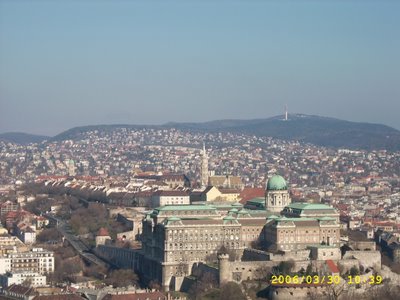 Hilly Buda side.
Hilly Buda side.
 Elizabeth Bridge. It was the world's longest suspension bridge in 1903 until 1926. Unfortunately the original bridge was destroyed by the German soldiers in 1945 and a replacement bridge (picture) was built in 1964. The River Danube separates hilly Buda from flat Pest (right-hand-side of photo).
Elizabeth Bridge. It was the world's longest suspension bridge in 1903 until 1926. Unfortunately the original bridge was destroyed by the German soldiers in 1945 and a replacement bridge (picture) was built in 1964. The River Danube separates hilly Buda from flat Pest (right-hand-side of photo).
 Parliament House- the permanent site of the national assembly. It's the largest building in the country. There are 691 rooms in the building. It's 268m long and the cupola extends 96m into the air.
Parliament House- the permanent site of the national assembly. It's the largest building in the country. There are 691 rooms in the building. It's 268m long and the cupola extends 96m into the air.
 Part of the castle wall surrounding the old palace from the 13th to 20th century. This "house" resembles a face with two eyes and a big mouth. haha!
Part of the castle wall surrounding the old palace from the 13th to 20th century. This "house" resembles a face with two eyes and a big mouth. haha!
 More of the castle wall.
More of the castle wall.
 View of the Chain Bridge. This is the capital's first bridge built in 1839. It took 10 years to complete but was destroyed during WWII. It was subsequently rebuilt in 1949 on its 100th anniversary. It plays a symbolic role in linking Buda and Pest.
View of the Chain Bridge. This is the capital's first bridge built in 1839. It took 10 years to complete but was destroyed during WWII. It was subsequently rebuilt in 1949 on its 100th anniversary. It plays a symbolic role in linking Buda and Pest.
 Central Market Hall. Looks like a Chinatown stall during Chinese New Year. Haha!
Central Market Hall. Looks like a Chinatown stall during Chinese New Year. Haha!
 Hõsök tere(Heroes's Square). It was built in 1896 to commerate the 1000th anniversary of Hungary. The statue of the Archangel Gabriel stands on top of the 36m high column in the centre. According to legend, the angel appeared to the first king - King Stephen- and helped him make the country a strong Christian state.
Hõsök tere(Heroes's Square). It was built in 1896 to commerate the 1000th anniversary of Hungary. The statue of the Archangel Gabriel stands on top of the 36m high column in the centre. According to legend, the angel appeared to the first king - King Stephen- and helped him make the country a strong Christian state.
 Capital of Norway: Oslo. It looks just like other European cities but smaller though.
Capital of Norway: Oslo. It looks just like other European cities but smaller though. Wildflowers or planted by man?
Wildflowers or planted by man? At the Sculpture Garden in Oslo. Various sculptures depicting different aspects of Life.
At the Sculpture Garden in Oslo. Various sculptures depicting different aspects of Life.
 This angry kid is a poster boy for many postcards. don't know why.
This angry kid is a poster boy for many postcards. don't know why. Taking the Scenic railway from Myrdal to Voss to take the fjord cruise. The railway route certainly lives up to its name.
Taking the Scenic railway from Myrdal to Voss to take the fjord cruise. The railway route certainly lives up to its name.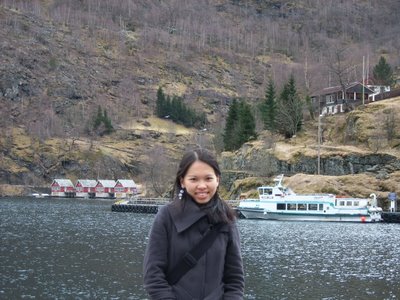 At Voss. Waiting for the fjord cruise. That's not the ferry in the background.
At Voss. Waiting for the fjord cruise. That's not the ferry in the background. Lovers: Grace and me. haha!
Lovers: Grace and me. haha! The fjord cruise route in the background.
The fjord cruise route in the background. Me, Grace and Sharon. ;)
Me, Grace and Sharon. ;) Me and my future colleague- Grace. ;)
Me and my future colleague- Grace. ;) Europe's smallest church is found here according to the cruise commentary. I have yet to figure out the building. :)
Europe's smallest church is found here according to the cruise commentary. I have yet to figure out the building. :)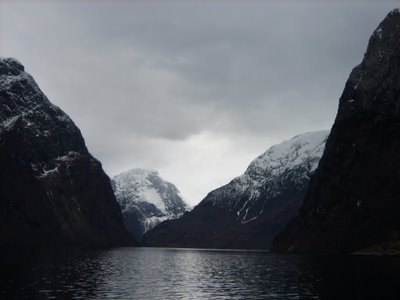 Fjord in Spring.
Fjord in Spring. Bergen: the old capital of Norway. We made a trip up to the top of the hill.
Bergen: the old capital of Norway. We made a trip up to the top of the hill. More of Bergen. I like the little "lake" at the background. It's a little sanctuary hidden from the city.
More of Bergen. I like the little "lake" at the background. It's a little sanctuary hidden from the city.
 Stream of water.
Stream of water.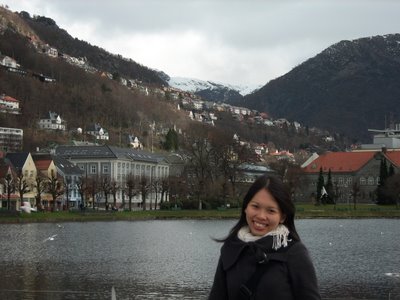 A lake in the middle of Bergen city.
A lake in the middle of Bergen city.  View from the train from Bergen back to Oslo.
View from the train from Bergen back to Oslo.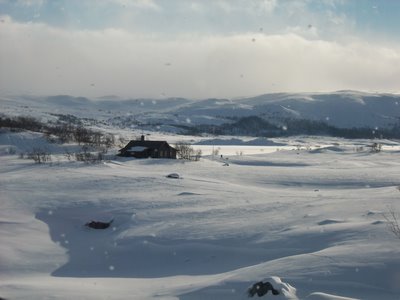 The train also passes through mountainous areas where thick snow prevails.
The train also passes through mountainous areas where thick snow prevails. 














































 Gellert Hill. The Citadel (a former fortress) sits on top of the hill. The top offers an unrivalled panorama of the entire city.
Gellert Hill. The Citadel (a former fortress) sits on top of the hill. The top offers an unrivalled panorama of the entire city.






